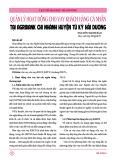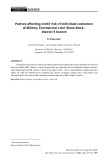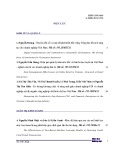
http://www.iaeme.com/IJM/index.asp 320 editor@iaeme.com
International Journal of Management (IJM)
Volume 7, Issue 7, November–December 2016, pp.320–335, Article ID: IJM_07_07_036
Available online at
http://www.iaeme.com/ijm/issues.asp?JType=IJM&VType=7&IType=7
Journal Impact Factor (2016): 8.1920 (Calculated by GISI) www.jifactor.com
ISSN Print: 0976-6502 and ISSN Online: 0976-6510
© IAEME Publication
MANAGEMENT CONTROL SYSTEMS IN NEPALESE
COMMERCIAL BANKS
Dr. Jitendra Prasad Upadhyay
Associate Professor, Tribhuvan University, Nepal Commerce Campus, Kathmandu,Nepal
ABSTRACT
Purpose – The purpose of this study is to examine whether the mechanisms of MCS have been
adequately developed and applied in the Nepalese commercial banks or not.
Methodology Used – Descriptive and analytical research designs have been used for the study.
Primary data have been collected through the questionnaires using convenience and judgmental
sampling from the Nepalese commercial banks. Questionnaires have been developed in five scales
and mean, standard deviation, coefficient of variation, correlation and factor analysis have been
used as tools. Cronbach’s alpha test has been done to test the reliability of the data.
Findings – All the commercial banks have applied the mechanisms of MCS.
Key words: Management Control Systems.
Cite this Article: Dr. Jitendra Prasad Upadhyay, Management Control Systems in Nepalese
Commercial Banks. International Journal of Management, 7(7), 2016, pp. 320–335.
http://www.iaeme.com/IJM/issues.asp?JType=IJM&VType=7&IType=7
1. BACKGROUND
A management control system (MCS) is a logical integration of techniques to gather and use information
to make planning and control decisions, to motivate employee behavior, and to evaluate performance. It
refers to the design, installation and operation of management planning and control systems. MCS is the
formal, information based, routine and procedure managers use to maintain or alter patterns in
organizational activities (Simons, 1995). Conventionally, the term "Management Control Systems" refers
to the deployment of various techniques in hierarchical organizations in order to monitor and measure
employee performance against certain management targets. In this sense, conventional MCS that focuses
on improving operational effectiveness is no longer sufficient to create sustainable competitive advantages.
MCS must be expanded to managerial practices that cultivate employee cooperation and creativity in the
discovery and exploitation of new business opportunities (Cusumano, 1997). MCS embodies the
techniques & mechanisms which companies employ to pursue strategies to accomplish goals successfully.
MCS integrates, motivates, assists decision making, communicates objectives, provides feedback etc.
Management Controls fall into two general categories (Simon, 1995): the first category involves
output controls in which specific outcomes, e.g. division profit and budget variances are measured,
monitored, compared against expectations, and corrective action taken when appropriate. This category
also includes administrative controls or action controls that involve formal rules, standard procedures and
manuals, and monitoring compliance there with. The second category includes behavior control, personnel

Management Control Systems in Nepalese Commercial Banks
http://www.iaeme.com/IJM/index.asp 321 editor@iaeme.com
control and social control. This category involves such controls as shared values and norms, along with
group interaction to maintain them, selection and placement of personnel with desired skills and attitudes,
work design and allocation and observation of the work behavior of personnel.
A well designed MCS aids and coordinates the process of making decisions and motivates individuals
throughout the organization to act. It also facilitates forecasting revenue and cost-driver levels, budgeting,
measuring, and evaluating performance (Kaplan & Atkinson, 2005). Anthony (1997) explained four steps
in the MCS process in sequence as they are found in practice. They are programming, budgeting, execution
and evaluation. Similarly, Jawahar Lal (2003) described three steps of MCS they are strategy formulation,
management control and task control
Thus, MCS is the formal, information-based routine and procedure managers use to maintain or alter
patterns in organizational activities. It facilitates the accomplishment of an organization’s strategic
objectives. It defines the decision space of individuals within an organization in order to affect their
behavior (Simons, 1995). It can be defined as a system that comprises a combination of control
mechanisms designed and implemented by management to increase the probability that organizational
actors will behave in ways consistent with the objectives set for the organization. It is a process for
motivating and inspiring people to perform organizational activities that will help to achieve the
organizational goals. It is also a process for detecting and correcting unintentional performance errors and
intentional irregularities, such as theft or misuse of resources.
2. MECHANISMS OF MANAGEMENT CONTROL SYSTEM
The different mechanisms of MCS are Total Quality Management, Time Based Management, Activity
Based Costing, Balance Score Card, Bench Marking, Re-engineering, Shareholder Value Analysis and
Continuous Improvement Process.
Total Quality Management is defined as a philosophy of management that is driven by continued
improvement and responding to customer needs and expectations. Different elements of TQM are
“Customer Satisfaction, Continuous Improvement, Standardized Product Quality, Employee Involvement
and Decision Making and Top Management Commitment”.
Time Based Management is the management philosophy which places highest value to time as a scarce
resource. This philosophy enlightens managers to properly divide their time and optimally utilize &
manage it efficiently and effectively. Different elements of TBM are “Time Resource, Time Saving
Pattern, Time Management Technique, Category Activities and Productivity Consciousness”.
The Activity-Based Costing is a costing system which focuses on activities performed to produce
products. ABC is that costing in which costs are first traced to activities and then to products. Different
elements of ABC are “Activity Costing, Major Activities, Cost to Cost Pool, Cost Activity and Cost
Driver”.
The Balanced Scorecard translates an organization’s mission and strategy into a comprehensive set of
performance measures that provides the framework for a strategies measurement and management system.
Different elements of BSC are “Financial Perspective, Customer Perspective, Internal Business Process
and Learning and Growth”.
Re-Engineering refers to a radical redesign of all or part of a company’s work processes to improve
productivity and financial performance. Different elements of RE are “Degree of Re-design, Traditional
Approach, Organization Restructuring, Organization Effectiveness and Efficiency and Re-engineering
Incentives”.
Bench Marking is the continuous process of measuring one’s own product, services and activities against
the best level of performance. These best levels of performance may be found either inside one’s own
organization or in other competing organizations or in organizations having similar processes. Different
elements of BM are “Performance Benchmarking, Improvement Effort, Management Commitment and
Benchmarking Types”.

Dr. Jitendra Prasad Upadhyay
http://www.iaeme.com/IJM/index.asp 322 editor@iaeme.com
Shareholder Value Analysis calculates the value of a company by looking at the returns it gives to
shareholders, and is based on the view that the objective of company directors is to maximise the wealth of
the company's shareholders. Different elements of SVA are “Estimating Shareholder Value, Wealth &
Profit and Use of Shareholder Value.
Continuous Improvement Process is an ongoing effort to improve product, services or processes. These
efforts can seek “incremental” improvement over time or “breakthrough” improvement all at once.
Different elements of CIP are “Implementing Continuous Improvement, Involvement of Employee,
Customer Satisfaction and Organization Quality and Performance.
3. COMMERCIAL BANKS IN NEPAL
A bank can be defined as the financial intermediary between depositors and entrepreneurs. The
intermediation takes place when banks accept deposit from general public, corporate bodies and private
organizations and deploy that deposit for profitable purposes in the forms of loans and advances. A bank is
also a financial service institution that generates its earnings primarily by means of intermediations. A
bank or banker is a dealer in debts, his own and other people’s (Shekhar & Shekhar, 2000).
According, to Nepal Commercial Bank Act 2031 B.S. “A commercial bank refers to such type of bank
which deals in money exchange, accepting deposits and advancing loans and other commercial
transactions other than some special functions performed by specified bank such as co-operative,
agriculture and industrial bank.”
List of Commercial Banks in Nepal
S.N. Names Operation Date
1 Nepal Bank Limited 1957
2 Rastriya Banijya Bank 1966
3 Agriculture Development Bank Limited 1968
4 Nabil Bank Limited 1984
5 Nepal Investment Bank Limited 1986
6 Standard Chartered Bank Nepal Limited 1987
7 Himalayan Bank Limited 1993
8 Nepal SBI Bank Limited 1993
9 Nepal Bangladesh Bank Limited 1994
10 Everest Bank Limited 1994
11 Bank of Kathmandu Limited 1995
12 Machhapuchhre Bank Limited 2000
13 Kumari Bank Limited 2001
14 Laxmi Bank Limited 2002
15 Siddhartha Bank Limited 2002
16 Global Bank Limited 2007
17 Citizens Bank International Limited 2007
18 Prime Commercial Bank Limited 2007
19 Sunrise Bank Limited 2007
20 Development Credit Bank Limited 2008
21 NMB Bank Limited 2008
22 Prabhu Bank Limited 2009
23 Janta Bank Limited 2010
24 Megha Bank Limited 2010
25 Civil Bank Limited 2010
26 Century Commercial Bank Limited 2010
27 Sanima Bank Limited 2011
28 NIC Asia Bank Limited 2013
(Source:
http:List of Commercial Banks_in_Nepal
, September, 08, 2016)

Management Control Systems in Nepalese Commercial Banks
http://www.iaeme.com/IJM/index.asp 323 editor@iaeme.com
4. OBJECTIVES OF THE STUDY
The main objectives of the study are to analyze:
• If the mechanisms of MCS have been adequately developed and applied in the Nepalese commercial banks
or not
• Whether all the elements of MCS mechanisms have been considered to be equally important by all the
selected banks or not
• If all the commercial banks have adopted mechanisms of MCS in equal degree or not
5. RATIONALES OF THE STUDY
The rationales of the present study are:
• The study will be definitely an eye opener to the management of the concerned banks regarding how far
their banks have been able to utilize the modern concept of MCS.
• Not only to the concerned but other organizations in different industries can also apply MCS approaches for
betterment of their organization
• The present research will be important for the future researchers also as they have insights about how to
carry out research on different organizations using the MCS with suitable methodology.
6. LIMITATIONS OF THE STUDY
The study has been exposed to the following limitations:
• Out of total twenty eight commercial banks in Nepal only six commercial banks have been considered.
• Only eight mechanisms of MCS have been tested, i.e. TQM, TBM, BSC, ABC, BM, RE, CIP AND SVA.
• Interviews with top, middle level and lower level employees have been taken.
7. REVIEW OF PREVIOUS STUDIES
The literature review has indicated that management control system and organization performance are
related. MCS influences in organization performance. MCS is function of organizational strategy and
organizational structure which determines the financial responsibility assigned to managers (Vancil, 1973).
Two distinct objectives, i.e. managerial objectives and technical objectives can be accomplished by means
of MCS. Management should focus on the effectiveness of the MCS rather than the degree of
sophistication of MCS (Bhattacharya & et. al., 1975). MCS should not be limited to operational level but
should be expanded to strategic level (Kimura & et. al., 2000).
Organizational transformation is situated between design and mobilization of management control
systems. A management control system is never in the point of equilibrium, but always in the phase of
transition (Mouritsen, 2005).
All managers, either of profit or non-profit making organizations, use control system of one form or
another. As the organization grows in size and complexity, the control system also tends to be from simple
to sophisticate (Rotch, 1993). Even the managers of NPOs have been found to have widely used MCS to
improve their organizational effectiveness. MCS is a necessary tool for leading an organization efficiently
towards its goals (Baraldi, 1998). It is more important to analyze MCS in combinations than single MCS.
MCS, in practice, is built by implementing appropriate combinations, i.e. MCS mixes (i.e. TQM, TBM,
ABC, BSC, BM, RE, EVA, PM, TOC, MRP, VCA, CIP and SVA etc. (Wingren et. al., 2003).
Although various studies have been conducted on MCS, most of them have focused on the importance
of MCS. And most of the research studies have tried to analyze the application of MCS in different
organizations, such as manufacturing, service, profit making and non-profit making.
The present study has examined the nature & magnitude of application of MCS in the Nepalese
commercial banks.

Dr. Jitendra Prasad Upadhyay
http://www.iaeme.com/IJM/index.asp 324 editor@iaeme.com
8. METHODOLOGY USED
This study has followed both descriptive and analytical approach of research. A questionnaire survey has
been conducted for getting the answer of research questions. Both primary and secondary data have been
analyzed using the analytical statistical tools; the means and the standard deviation, coefficient of variance,
correlation and factors have been calculated for analyzing the responses.
There are total of twenty eight commercial banks in Nepal, which constitute the population of the
study. For this study, only four commercial banks, i.e. Standard Chartered Bank, Himalayan Bank Limited,
Nabil Bank Limited and Kumari Bank Limited have been selected as sample banks. Selection of sample
banks was based on convenience and judgmental basis.
The eight-page questionnaire including 100 questions, were distributed to twenty four top, middle and
lower level employees of various departments of each bank.
8.1. Respondent’s Profile
8.1.1. Gender Wise Respondents
Name of the Banks Male (No.) % Female (No.) % Total
Standard Chartered Bank Limited 14 14.58 10 10.42 24
Nabil Bank Limited 16 16.67 8 8.33 24
Kumari Bank Limited 13 13.54 11 11.46 24
Himalayan Bank Limited 15 15.63 9 9.37 24
Total 58 60.42 38 39.58 96
Above table depicts the characteristics of the respondents’ gender wise. Majority of respondents were
males, i.e. 60.42%. But female respondents were also satisfactory in number, i.e. 38 out of 96. The reason
behind low number of female respondents is that all banks have high number of male employee.
8.1.2. Age Wise Respondents
Name of the Banks below
30 % 30-40 % 40 - 50 % above
50 % Total
Standard Chartered Bank
Ltd. 6 6.25 11 11.47 4 4.17 3 3.12 24
Nabil Bank Limited 0 0 12 12.5 8 8.33 4 4.17 24
Kumari Bank Limited 8 8.33 12 12.5 4 4.17 0 0 24
Himalayan Bank Limited 3 3.12 12 12.5 6 6.25 3 3.12 24
Total 17 17.70 47 48.97 22 22.92 10 10.41 96
Above table presents the characteristics of respondents’ age wise. Majority of respondents were found
to be between 30 to 40 years group, i.e. 48.97%. Very few respondents fall in the category of above 50
years group, i.e. 10.41%. Respondents in category 40 to 50 years group were higher than below 30 years,
i.e. 22.92% is greater than 17.70%.


























